Decoding NIH Stroke Scale: Thrombolysis Insights
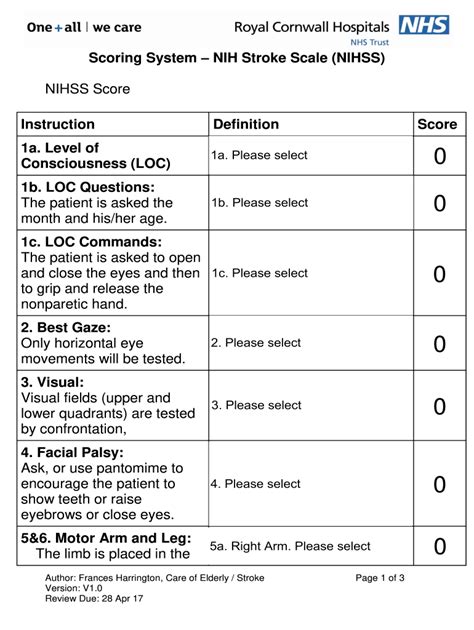
Unlock the power of NIH Stroke Scale for thrombolysis. Explore its role in acute stroke care, empowering healthcare decisions for improved patient outcomes.
In the realm of acute ischemic stroke management, the NIH Stroke Scale for Thrombolysis stands as a critical instrument, guiding healthcare professionals in the assessment and decision-making processes. As we delve into the intricate landscape of healthcare, this article will meticulously unravel the significance and application of this standardized neurological assessment tool. In the pursuit of comprehensive understanding, it becomes imperative to navigate the nuances of thrombolysis in stroke care, fostering an environment where informed decisions can be made with precision and efficacy. With an unwavering commitment to objectivity, this discourse seeks to illuminate the role and impact of the NIH Stroke Scale within the broader healthcare context, shedding light on its pivotal role in enhancing patient outcomes.
Top 10 Points about NIH Stroke Scale for Thrombolysis :
- Introduction to NIH Stroke Scale
- Importance in Thrombolysis Decision-making
- Components of NIH Stroke Scale Assessment
- Scoring and Interpretation Guidelines
- Application in Acute Ischemic Stroke Management
- Enhancing Clinical Decision Precision
- NIH Stroke Scale's Role in Thrombolysis Eligibility
- Impact on Patient Outcomes
- Integration into Stroke Care Protocols
- Future Perspectives and Developments
Several facts about NIH Stroke Scale for Thrombolysis
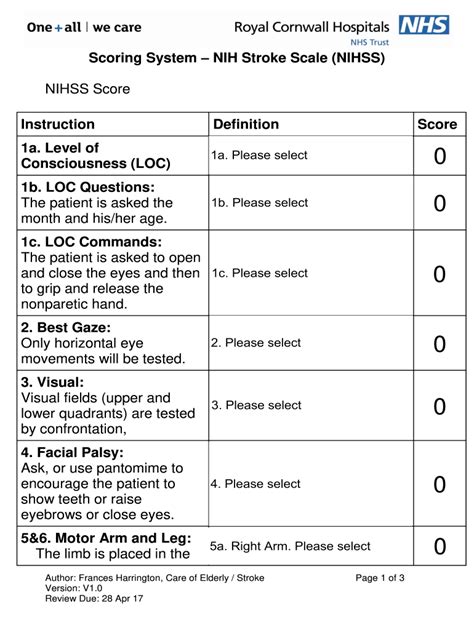
Introduction to NIH Stroke Scale
Within the intricate landscape of acute ischemic stroke care, the NIH Stroke Scale for Thrombolysis emerges as a pivotal tool, guiding healthcare professionals in the assessment and decision-making processes. This standardized neurological assessment scale provides a comprehensive framework for evaluating the severity of a stroke, laying the foundation for tailored treatment strategies.
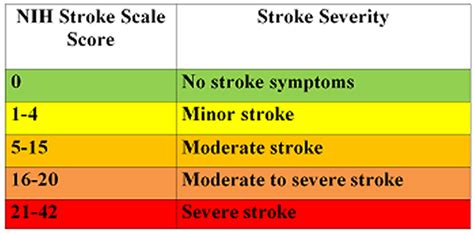
Importance in Thrombolysis Decision-making
One cannot overstate the significance of the NIH Stroke Scale in the critical decision-making juncture of thrombolysis. As healthcare professionals grapple with the urgency of initiating thrombolytic therapy, this scale serves as a reliable compass, offering a standardized assessment that aids in identifying eligible patients for this time-sensitive intervention.

Components of NIH Stroke Scale Assessment
Understanding the intricacies of the NIH Stroke Scale necessitates a closer examination of its components. From assessing consciousness to motor skills and sensory functions, this scale meticulously examines various facets of neurological function, providing a nuanced and comprehensive evaluation.

Scoring and Interpretation Guidelines
The numerical scores generated through the NIH Stroke Scale hold profound implications for clinical decision-making. This section delves into the scoring system and the nuanced interpretation guidelines, offering insights into how healthcare professionals derive actionable information from the assessment.
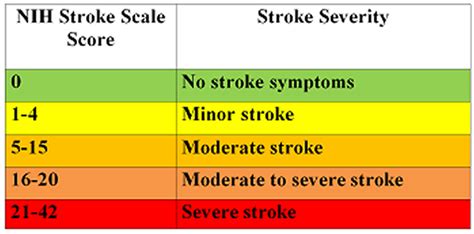
Application in Acute Ischemic Stroke Management
The seamless integration of the NIH Stroke Scale into acute ischemic stroke management is paramount. This paragraph explores real-world scenarios and showcases how healthcare practitioners leverage the scale to make informed decisions, contributing to the overall efficacy of patient care.

Enhancing Clinical Decision Precision
Bolstering the precision of clinical decisions in stroke care is a shared goal. This section delves into how the NIH Stroke Scale, with its standardized approach, enhances the precision of clinical decisions, ensuring that interventions align seamlessly with the individual needs of the patient.
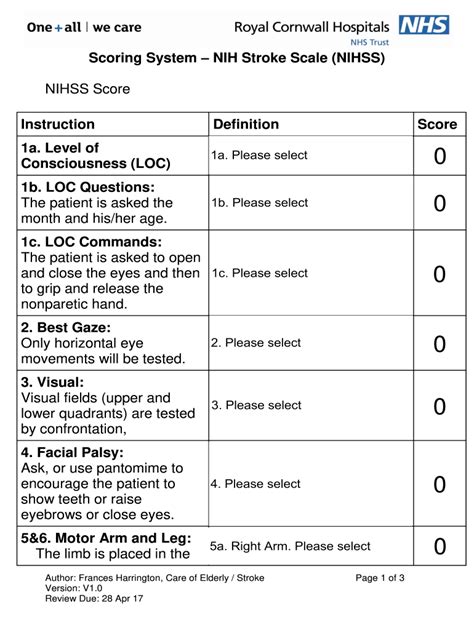
NIH Stroke Scale's Role in Thrombolysis Eligibility
The eligibility criteria for thrombolysis hinge significantly on the insights derived from the NIH Stroke Scale. This segment explores the specific parameters within the scale that influence the determination of a patient's suitability for thrombolytic therapy, ensuring a meticulous and tailored approach to treatment.
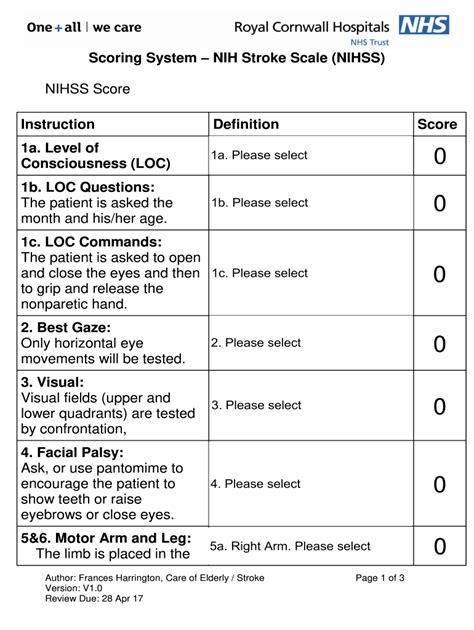
Impact on Patient Outcomes
The ultimate measure of any medical intervention lies in its impact on patient outcomes. Here, we examine how the NIH Stroke Scale plays a pivotal role in shaping and influencing the trajectory of patient recovery, underscoring its significance in the broader context of healthcare.
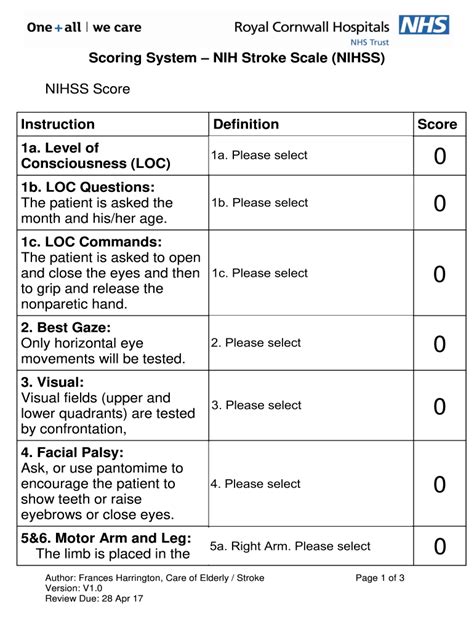
Integration into Stroke Care Protocols
For the NIH Stroke Scale to realize its full potential, seamless integration into stroke care protocols is essential. This paragraph explores the practical aspects of incorporating the scale into established protocols, ensuring a cohesive and standardized approach to stroke care.

Future Perspectives and Developments
As healthcare continually evolves, so too does the NIH Stroke Scale. This concluding section casts a gaze into the future, discussing potential developments and enhancements to the scale that may further refine its utility in acute ischemic stroke care.
Sources: American Stroke Association, National Institute of Neurological Disorders and Stroke.
NIH Stroke Scale for Thrombolysis in Professional's eye
In the ever-evolving landscape of healthcare, the
NIH Stroke Scale for Thrombolysis stands as an indispensable tool, shaping the trajectory of acute ischemic stroke management. This standardized neurological assessment scale, designed to objectively quantify the severity of a stroke, plays a pivotal role in informing critical decisions related to thrombolytic therapy. As healthcare professionals navigate the complexities of acute stroke care, a nuanced understanding of the
NIH Stroke Scale becomes paramount, influencing not only the eligibility criteria for thrombolysis but also the broader landscape of patient outcomes.

Introduction to NIH Stroke Scale
The journey through the intricacies of acute ischemic stroke care begins with a comprehensive grasp of the NIH Stroke Scale. Designed as a standardized assessment tool, it systematically evaluates various neurological functions to quantify the extent of stroke severity. This initial stage lays the foundation for a meticulous examination, emphasizing the need for a standardized approach in evaluating and addressing acute ischemic stroke cases.

Importance in Thrombolysis Decision-making
As the urgency to initiate thrombolytic therapy looms, the NIH Stroke Scale assumes a critical role in guiding decision-making processes. By offering an objective and quantifiable assessment of the neurological deficits resulting from a stroke, healthcare professionals gain valuable insights into the eligibility of patients for thrombolysis. This emphasis on a standardized approach ensures that decisions align with the urgency of the situation, optimizing the timeliness and appropriateness of interventions.

Components of NIH Stroke Scale Assessment
A closer examination of the NIH Stroke Scale reveals its intricate components, each playing a crucial role in the comprehensive evaluation of a patient's neurological status. From assessing consciousness and gaze to motor skills and sensory functions, the scale employs a systematic approach that allows healthcare professionals to capture a detailed and nuanced picture of the impact of the stroke on the patient's neurological functions.

Scoring and Interpretation Guidelines
The numerical scores generated through the NIH Stroke Scale become the cornerstone for informed decision-making. These scores, meticulously derived from the assessment's various components, provide healthcare professionals with a standardized metric for gauging the severity of a stroke. The interpretation guidelines associated with these scores offer a structured framework, ensuring consistency and reliability in the assessment's outcomes.

Application in Acute Ischemic Stroke Management
The seamless integration of the NIH Stroke Scale into the broader context of acute ischemic stroke management amplifies its significance. Real-world scenarios underscore the practical application of the scale, showcasing how healthcare practitioners leverage its insights to make informed decisions. This integration ensures a cohesive and standardized approach to acute ischemic stroke management, with the scale serving as a guiding compass for tailored and patient-centric interventions.

Enhancing Clinical Decision Precision
Within the realm of acute ischemic stroke care, the NIH Stroke Scale emerges as a key player in enhancing the precision of clinical decisions. By providing a standardized and quantifiable assessment, healthcare professionals can tailor interventions with a heightened level of accuracy. This emphasis on precision ensures that the chosen interventions align seamlessly with the individual needs of the patient, promoting a more targeted and effective approach to care.

NIH Stroke Scale's Role in Thrombolysis Eligibility
The eligibility criteria for thrombolysis hinge significantly on the insights derived from the NIH Stroke Scale. This section explores the specific parameters within the scale that influence the determination of a patient's suitability for thrombolytic therapy. The scale's role in this context underscores its critical contribution to the decision-making process, ensuring that thrombolysis is administered with precision and adherence to established criteria.

Impact on Patient Outcomes
Ultimately, the efficacy of any medical intervention lies in its impact on patient outcomes. Within the context of acute ischemic stroke care, the NIH Stroke Scale plays a pivotal role in shaping and influencing the trajectory of patient recovery. By providing a standardized assessment that informs tailored interventions, the scale contributes to improved outcomes, underscoring its significance in the broader landscape of healthcare.

Integration into Stroke Care Protocols
For the NIH Stroke Scale to realize its full potential, seamless integration into established stroke care protocols is essential. This section explores the practical aspects of incorporating the scale into existing frameworks, ensuring that its use becomes a standard practice. The integration into protocols not only fosters consistency but also streamlines the decision-making process, contributing to a more cohesive and standardized approach to stroke care.

Future Perspectives and Developments
As healthcare continues its evolution, the NIH Stroke Scale remains subject to ongoing refinements and advancements. This concluding section casts a gaze into the future, discussing potential developments and enhancements to the scale. By staying attuned to emerging perspectives, the healthcare community can ensure that the NIH Stroke Scale continues to evolve, adapting to the ever
Point of Views : NIH Stroke Scale for Thrombolysis
In the realm of acute ischemic stroke management, the
NIH Stroke Scale for Thrombolysis serves as an indispensable tool, objectively quantifying the severity of strokes to guide informed decisions in healthcare.Developed as a standardized neurological assessment scale, the
NIH Stroke Scale systematically evaluates various components, including consciousness, gaze, motor skills, and sensory functions, providing healthcare professionals with a comprehensive understanding of a patient's neurological status.The scale's numerical scoring system becomes a crucial metric for decision-making, offering a quantifiable measure of stroke severity. These scores, derived from meticulous assessments, lay the foundation for interpreting the extent of neurological deficits.In the urgent context of thrombolysis decision-making, the
NIH Stroke Scale plays a critical role. By offering a standardized and objective assessment, healthcare professionals can swiftly identify eligible patients for thrombolytic therapy, optimizing the timeliness and appropriateness of interventions.The integration of the
NIH Stroke Scale into acute ischemic stroke management ensures a cohesive and standardized approach. Real-world applications showcase how the scale's insights empower healthcare practitioners to make informed decisions, contributing to the overall efficacy of patient care.Precision in clinical decision-making is paramount, and the
NIH Stroke Scale emerges as a key player in enhancing this precision. Its standardized approach allows healthcare professionals to tailor interventions with accuracy, aligning seamlessly with the individual needs of each patient.Thrombolysis eligibility criteria heavily rely on the insights derived from the
NIH Stroke Scale. Specific parameters within the scale influence the determination of a patient's suitability for thrombolytic therapy, ensuring that this time-sensitive intervention is administered with precision.Ultimately, the impact of the
NIH Stroke Scale extends to patient outcomes. By shaping and influencing the trajectory of patient recovery through informed and tailored interventions, the scale contributes significantly to improved outcomes in acute ischemic stroke cases.For the
NIH Stroke Scale to fulfill its potential, seamless integration into established stroke care protocols is essential. This not only fosters consistency but also streamlines the decision-making process, contributing to a more cohesive and standardized approach to stroke care.As healthcare continues to evolve, the
NIH Stroke Scale remains subject to ongoing refinements and advancements. A forward-looking perspective acknowledges the need for continual adaptation and enhancement, ensuring the scale's relevance and effectiveness in acute ischemic stroke management.
Conclusion :As we conclude our exploration into the intricacies of acute ischemic stroke care, centered around the NIH Stroke Scale for Thrombolysis, we trust that this comprehensive journey has provided valuable insights into the standardized neurological assessment tool's pivotal role in healthcare decision-making. The nuanced examination of the NIH Stroke Scale's components, scoring system, and its profound impact on thrombolysis eligibility criteria underscores its significance in the acute care landscape. We invite you to reflect on the importance of this scale in enhancing the precision of clinical decisions and ultimately shaping patient outcomes in the context of acute ischemic strokes.
As healthcare professionals continually strive for excellence, the seamless integration of the NIH Stroke Scale into stroke care protocols becomes imperative. The real-world application scenarios highlighted in our exploration showcase the practical significance of this standardized assessment tool, offering a glimpse into its role in informing tailored interventions. Looking ahead, with an ever-evolving healthcare landscape, the NIH Stroke Scale for Thrombolysis remains an instrumental guide, ensuring a standardized and objective approach to acute ischemic stroke management. We appreciate your engagement and hope this exploration fosters a deeper understanding of the critical role the NIH Stroke Scale plays in shaping the landscape of healthcare decisions and patient outcomes.
Questions and Answer for NIH Stroke Scale for Thrombolysis
Q: What is the NIH Stroke Scale for Thrombolysis?
- A: The NIH Stroke Scale for Thrombolysis is a standardized neurological assessment tool used to quantify the severity of acute ischemic strokes. It helps healthcare professionals make informed decisions regarding thrombolytic therapy, offering a systematic evaluation of various neurological functions.
Q: How is the NIH Stroke Scale scored?
- A: The NIH Stroke Scale is scored based on a numerical system that quantifies the degree of impairment in different neurological domains. Healthcare professionals assess factors such as consciousness, gaze, motor skills, and sensory functions, assigning scores that collectively provide a comprehensive picture of stroke severity.
Q: What role does the NIH Stroke Scale play in thrombolysis eligibility?
- A: The NIH Stroke Scale plays a crucial role in determining thrombolysis eligibility. By providing objective and standardized insights into the neurological deficits caused by a stroke, healthcare professionals can assess whether a patient meets the criteria for thrombolytic therapy, ensuring timely and appropriate interventions.
Q: How does the NIH Stroke Scale impact patient outcomes?
- A: The NIH Stroke Scale significantly influences patient outcomes by guiding tailored interventions. Its standardized assessment allows healthcare professionals to make precise decisions, shaping the trajectory of patient recovery. The scale contributes to improved outcomes in acute ischemic stroke cases through its role in informing targeted and effective care.
Q: Is the NIH Stroke Scale integrated into stroke care protocols?
- A: Yes, the NIH Stroke Scale is seamlessly integrated into established stroke care protocols. Its standardized approach fosters consistency in decision-making, ensuring that the scale becomes a standard practice in acute ischemic stroke management. The integration contributes to a cohesive and standardized approach, enhancing the overall efficacy of stroke care.
Label :NIH Stroke Scale, Thrombolysis, Healthcare Decisions, Standardized Assessment
Keyword : NIH Stroke Scale for Thrombolysis

Unlock the power of NIH Stroke Scale for thrombolysis. Explore its role in acute stroke care, empowering healthcare decisions for improved patient outcomes.
In the realm of acute ischemic stroke management, the NIH Stroke Scale for Thrombolysis stands as a critical instrument, guiding healthcare professionals in the assessment and decision-making processes. As we delve into the intricate landscape of healthcare, this article will meticulously unravel the significance and application of this standardized neurological assessment tool. In the pursuit of comprehensive understanding, it becomes imperative to navigate the nuances of thrombolysis in stroke care, fostering an environment where informed decisions can be made with precision and efficacy. With an unwavering commitment to objectivity, this discourse seeks to illuminate the role and impact of the NIH Stroke Scale within the broader healthcare context, shedding light on its pivotal role in enhancing patient outcomes.
Top 10 Points about NIH Stroke Scale for Thrombolysis :
- Introduction to NIH Stroke Scale
- Importance in Thrombolysis Decision-making
- Components of NIH Stroke Scale Assessment
- Scoring and Interpretation Guidelines
- Application in Acute Ischemic Stroke Management
- Enhancing Clinical Decision Precision
- NIH Stroke Scale's Role in Thrombolysis Eligibility
- Impact on Patient Outcomes
- Integration into Stroke Care Protocols
- Future Perspectives and Developments
Several facts about NIH Stroke Scale for Thrombolysis

Introduction to NIH Stroke Scale
Within the intricate landscape of acute ischemic stroke care, the NIH Stroke Scale for Thrombolysis emerges as a pivotal tool, guiding healthcare professionals in the assessment and decision-making processes. This standardized neurological assessment scale provides a comprehensive framework for evaluating the severity of a stroke, laying the foundation for tailored treatment strategies.

Importance in Thrombolysis Decision-making
One cannot overstate the significance of the NIH Stroke Scale in the critical decision-making juncture of thrombolysis. As healthcare professionals grapple with the urgency of initiating thrombolytic therapy, this scale serves as a reliable compass, offering a standardized assessment that aids in identifying eligible patients for this time-sensitive intervention.

Components of NIH Stroke Scale Assessment
Understanding the intricacies of the NIH Stroke Scale necessitates a closer examination of its components. From assessing consciousness to motor skills and sensory functions, this scale meticulously examines various facets of neurological function, providing a nuanced and comprehensive evaluation.

Scoring and Interpretation Guidelines
The numerical scores generated through the NIH Stroke Scale hold profound implications for clinical decision-making. This section delves into the scoring system and the nuanced interpretation guidelines, offering insights into how healthcare professionals derive actionable information from the assessment.

Application in Acute Ischemic Stroke Management
The seamless integration of the NIH Stroke Scale into acute ischemic stroke management is paramount. This paragraph explores real-world scenarios and showcases how healthcare practitioners leverage the scale to make informed decisions, contributing to the overall efficacy of patient care.

Enhancing Clinical Decision Precision
Bolstering the precision of clinical decisions in stroke care is a shared goal. This section delves into how the NIH Stroke Scale, with its standardized approach, enhances the precision of clinical decisions, ensuring that interventions align seamlessly with the individual needs of the patient.

NIH Stroke Scale's Role in Thrombolysis Eligibility
The eligibility criteria for thrombolysis hinge significantly on the insights derived from the NIH Stroke Scale. This segment explores the specific parameters within the scale that influence the determination of a patient's suitability for thrombolytic therapy, ensuring a meticulous and tailored approach to treatment.

Impact on Patient Outcomes
The ultimate measure of any medical intervention lies in its impact on patient outcomes. Here, we examine how the NIH Stroke Scale plays a pivotal role in shaping and influencing the trajectory of patient recovery, underscoring its significance in the broader context of healthcare.

Integration into Stroke Care Protocols
For the NIH Stroke Scale to realize its full potential, seamless integration into stroke care protocols is essential. This paragraph explores the practical aspects of incorporating the scale into established protocols, ensuring a cohesive and standardized approach to stroke care.

Future Perspectives and Developments
As healthcare continually evolves, so too does the NIH Stroke Scale. This concluding section casts a gaze into the future, discussing potential developments and enhancements to the scale that may further refine its utility in acute ischemic stroke care.
Sources: American Stroke Association, National Institute of Neurological Disorders and Stroke.
NIH Stroke Scale for Thrombolysis in Professional's eye
In the ever-evolving landscape of healthcare, the
NIH Stroke Scale for Thrombolysis stands as an indispensable tool, shaping the trajectory of acute ischemic stroke management. This standardized neurological assessment scale, designed to objectively quantify the severity of a stroke, plays a pivotal role in informing critical decisions related to thrombolytic therapy. As healthcare professionals navigate the complexities of acute stroke care, a nuanced understanding of the
NIH Stroke Scale becomes paramount, influencing not only the eligibility criteria for thrombolysis but also the broader landscape of patient outcomes.

Introduction to NIH Stroke Scale
The journey through the intricacies of acute ischemic stroke care begins with a comprehensive grasp of the NIH Stroke Scale. Designed as a standardized assessment tool, it systematically evaluates various neurological functions to quantify the extent of stroke severity. This initial stage lays the foundation for a meticulous examination, emphasizing the need for a standardized approach in evaluating and addressing acute ischemic stroke cases.

Importance in Thrombolysis Decision-making
As the urgency to initiate thrombolytic therapy looms, the NIH Stroke Scale assumes a critical role in guiding decision-making processes. By offering an objective and quantifiable assessment of the neurological deficits resulting from a stroke, healthcare professionals gain valuable insights into the eligibility of patients for thrombolysis. This emphasis on a standardized approach ensures that decisions align with the urgency of the situation, optimizing the timeliness and appropriateness of interventions.

Components of NIH Stroke Scale Assessment
A closer examination of the NIH Stroke Scale reveals its intricate components, each playing a crucial role in the comprehensive evaluation of a patient's neurological status. From assessing consciousness and gaze to motor skills and sensory functions, the scale employs a systematic approach that allows healthcare professionals to capture a detailed and nuanced picture of the impact of the stroke on the patient's neurological functions.

Scoring and Interpretation Guidelines
The numerical scores generated through the NIH Stroke Scale become the cornerstone for informed decision-making. These scores, meticulously derived from the assessment's various components, provide healthcare professionals with a standardized metric for gauging the severity of a stroke. The interpretation guidelines associated with these scores offer a structured framework, ensuring consistency and reliability in the assessment's outcomes.

Application in Acute Ischemic Stroke Management
The seamless integration of the NIH Stroke Scale into the broader context of acute ischemic stroke management amplifies its significance. Real-world scenarios underscore the practical application of the scale, showcasing how healthcare practitioners leverage its insights to make informed decisions. This integration ensures a cohesive and standardized approach to acute ischemic stroke management, with the scale serving as a guiding compass for tailored and patient-centric interventions.

Enhancing Clinical Decision Precision
Within the realm of acute ischemic stroke care, the NIH Stroke Scale emerges as a key player in enhancing the precision of clinical decisions. By providing a standardized and quantifiable assessment, healthcare professionals can tailor interventions with a heightened level of accuracy. This emphasis on precision ensures that the chosen interventions align seamlessly with the individual needs of the patient, promoting a more targeted and effective approach to care.

NIH Stroke Scale's Role in Thrombolysis Eligibility
The eligibility criteria for thrombolysis hinge significantly on the insights derived from the NIH Stroke Scale. This section explores the specific parameters within the scale that influence the determination of a patient's suitability for thrombolytic therapy. The scale's role in this context underscores its critical contribution to the decision-making process, ensuring that thrombolysis is administered with precision and adherence to established criteria.

Impact on Patient Outcomes
Ultimately, the efficacy of any medical intervention lies in its impact on patient outcomes. Within the context of acute ischemic stroke care, the NIH Stroke Scale plays a pivotal role in shaping and influencing the trajectory of patient recovery. By providing a standardized assessment that informs tailored interventions, the scale contributes to improved outcomes, underscoring its significance in the broader landscape of healthcare.

Integration into Stroke Care Protocols
For the NIH Stroke Scale to realize its full potential, seamless integration into established stroke care protocols is essential. This section explores the practical aspects of incorporating the scale into existing frameworks, ensuring that its use becomes a standard practice. The integration into protocols not only fosters consistency but also streamlines the decision-making process, contributing to a more cohesive and standardized approach to stroke care.

Future Perspectives and Developments
As healthcare continues its evolution, the NIH Stroke Scale remains subject to ongoing refinements and advancements. This concluding section casts a gaze into the future, discussing potential developments and enhancements to the scale. By staying attuned to emerging perspectives, the healthcare community can ensure that the NIH Stroke Scale continues to evolve, adapting to the ever
Point of Views : NIH Stroke Scale for Thrombolysis
In the realm of acute ischemic stroke management, the
NIH Stroke Scale for Thrombolysis serves as an indispensable tool, objectively quantifying the severity of strokes to guide informed decisions in healthcare.Developed as a standardized neurological assessment scale, the
NIH Stroke Scale systematically evaluates various components, including consciousness, gaze, motor skills, and sensory functions, providing healthcare professionals with a comprehensive understanding of a patient's neurological status.The scale's numerical scoring system becomes a crucial metric for decision-making, offering a quantifiable measure of stroke severity. These scores, derived from meticulous assessments, lay the foundation for interpreting the extent of neurological deficits.In the urgent context of thrombolysis decision-making, the
NIH Stroke Scale plays a critical role. By offering a standardized and objective assessment, healthcare professionals can swiftly identify eligible patients for thrombolytic therapy, optimizing the timeliness and appropriateness of interventions.The integration of the
NIH Stroke Scale into acute ischemic stroke management ensures a cohesive and standardized approach. Real-world applications showcase how the scale's insights empower healthcare practitioners to make informed decisions, contributing to the overall efficacy of patient care.Precision in clinical decision-making is paramount, and the
NIH Stroke Scale emerges as a key player in enhancing this precision. Its standardized approach allows healthcare professionals to tailor interventions with accuracy, aligning seamlessly with the individual needs of each patient.Thrombolysis eligibility criteria heavily rely on the insights derived from the
NIH Stroke Scale. Specific parameters within the scale influence the determination of a patient's suitability for thrombolytic therapy, ensuring that this time-sensitive intervention is administered with precision.Ultimately, the impact of the
NIH Stroke Scale extends to patient outcomes. By shaping and influencing the trajectory of patient recovery through informed and tailored interventions, the scale contributes significantly to improved outcomes in acute ischemic stroke cases.For the
NIH Stroke Scale to fulfill its potential, seamless integration into established stroke care protocols is essential. This not only fosters consistency but also streamlines the decision-making process, contributing to a more cohesive and standardized approach to stroke care.As healthcare continues to evolve, the
NIH Stroke Scale remains subject to ongoing refinements and advancements. A forward-looking perspective acknowledges the need for continual adaptation and enhancement, ensuring the scale's relevance and effectiveness in acute ischemic stroke management.
Conclusion :As we conclude our exploration into the intricacies of acute ischemic stroke care, centered around the NIH Stroke Scale for Thrombolysis, we trust that this comprehensive journey has provided valuable insights into the standardized neurological assessment tool's pivotal role in healthcare decision-making. The nuanced examination of the NIH Stroke Scale's components, scoring system, and its profound impact on thrombolysis eligibility criteria underscores its significance in the acute care landscape. We invite you to reflect on the importance of this scale in enhancing the precision of clinical decisions and ultimately shaping patient outcomes in the context of acute ischemic strokes.
As healthcare professionals continually strive for excellence, the seamless integration of the NIH Stroke Scale into stroke care protocols becomes imperative. The real-world application scenarios highlighted in our exploration showcase the practical significance of this standardized assessment tool, offering a glimpse into its role in informing tailored interventions. Looking ahead, with an ever-evolving healthcare landscape, the NIH Stroke Scale for Thrombolysis remains an instrumental guide, ensuring a standardized and objective approach to acute ischemic stroke management. We appreciate your engagement and hope this exploration fosters a deeper understanding of the critical role the NIH Stroke Scale plays in shaping the landscape of healthcare decisions and patient outcomes.
Questions and Answer for NIH Stroke Scale for Thrombolysis
Q: What is the NIH Stroke Scale for Thrombolysis?
- A: The NIH Stroke Scale for Thrombolysis is a standardized neurological assessment tool used to quantify the severity of acute ischemic strokes. It helps healthcare professionals make informed decisions regarding thrombolytic therapy, offering a systematic evaluation of various neurological functions.
Q: How is the NIH Stroke Scale scored?
- A: The NIH Stroke Scale is scored based on a numerical system that quantifies the degree of impairment in different neurological domains. Healthcare professionals assess factors such as consciousness, gaze, motor skills, and sensory functions, assigning scores that collectively provide a comprehensive picture of stroke severity.
Q: What role does the NIH Stroke Scale play in thrombolysis eligibility?
- A: The NIH Stroke Scale plays a crucial role in determining thrombolysis eligibility. By providing objective and standardized insights into the neurological deficits caused by a stroke, healthcare professionals can assess whether a patient meets the criteria for thrombolytic therapy, ensuring timely and appropriate interventions.
Q: How does the NIH Stroke Scale impact patient outcomes?
- A: The NIH Stroke Scale significantly influences patient outcomes by guiding tailored interventions. Its standardized assessment allows healthcare professionals to make precise decisions, shaping the trajectory of patient recovery. The scale contributes to improved outcomes in acute ischemic stroke cases through its role in informing targeted and effective care.
Q: Is the NIH Stroke Scale integrated into stroke care protocols?
- A: Yes, the NIH Stroke Scale is seamlessly integrated into established stroke care protocols. Its standardized approach fosters consistency in decision-making, ensuring that the scale becomes a standard practice in acute ischemic stroke management. The integration contributes to a cohesive and standardized approach, enhancing the overall efficacy of stroke care.
Label :NIH Stroke Scale, Thrombolysis, Healthcare Decisions, Standardized Assessment
Keyword : NIH Stroke Scale for Thrombolysis
0 komentar